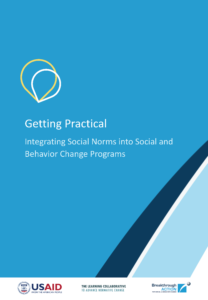Traduction française ci-dessous
When behavior change is a program goal, program planners need to understand if, how, when, and under what conditions the behavior is influenced by social norms (i.e., what people in a group believe is typical and appropriate behavior).
Social and behavior change program implementers may be aware that social norms are powerful influencers of behaviors and outcomes, yet they may be unsure how to integrate social norms-shifting programming into program design.
As new evidence and learning on the importance of social norms and how to shift or transform them to influence behavior emerge, there are more resources for implementers to put guidance into practice. This new tool, Getting Practical: Integrating Social Norms into Social and Behavior Change Programs (also available in French), was developed for country-level program planners, designers, and monitoring/research staff to address the gap between formative social norms research and the other phases of the program design cycle to allow for adaptive programming. It is the result of a participatory process of input and feedback organized by Breakthrough ACTION and the Learning Collaborative to Advance Normative Change.
What is included in the Getting Practical Tool?
In addition to this guide, Getting Practical includes:
- A slide deck for each of the four modules that facilitators can adapt and use to structure the workshop. Each slide deck has slides to introduce, conduct, and wrap up each individual activity.
- An introductory video that explains the purpose of the tool and quickly guides potential facilitators through how to use Getting Practical.
Getting Practical Feedback Form
Thank you for taking the time to use this tool! We hope that it enables your team to have a better understanding of social norms and how you can incorporate them to achieve your program’s behavioral objectives. Your honest and open feedback is essential to helping us refine and improve the tool for future users.
As you go through the tool, please answer the questions for each module in this feedback form. At the end of the questionnaire, there are two sections with questions on the structure and overall impressions of the tool.
Guide pratique : Intégrer les normes sociales dans les programmes de changement social et de comportement
Lorsque le changement de comportement est un objectif du programme, les planificateurs doivent comprendre si, comment, quand et dans quelles conditions le comportement est influencé par les normes sociales (c’est-à-dire ce que les personnes d’un groupe croient être un comportement typique et approprié).
Les responsables de la mise en œuvre des programmes de changement social et comportemental savent que les normes sociales influencent fortement les comportements et les résultats, mais ils ne savent pas toujours comment intégrer les programmes de changement des normes sociales dans la conception des programmes.
Au fur et à mesure qu’apparaissent de nouvelles preuves et de nouveaux apprentissages sur l’importance des normes sociales et sur la manière de les modifier ou de les transformer pour influencer le comportement, il existe davantage de ressources permettant aux responsables de la mise en œuvre de mettre les conseils en pratique. Ce nouvel outil, Guide pratique : Intégrer les normes sociales dans les programmes de changement social et de comportement (disponible en anglais), a été développé pour les planificateurs de programmes au niveau national, les concepteurs et le personnel de suivi/recherche afin de combler le fossé entre la recherche formative sur les normes sociales et les autres phases du cycle de conception des programmes pour permettre une programmation adaptative. Il est le résultat d’un processus participatif de contribution et de retour d’information organisé par Breakthrough ACTION et le Learning Collaborative to Advance Normative Change.
Qu’est-ce qui est inclus dans l’outil Guide pratique ?
En plus de ce guide, la Guide pratique comprend :
- Un jeu de diapositives pour chacun des quatre modules que les animateurs peuvent adapter et utiliser pour structurer l’atelier. Chaque jeu de diapositives a des diapositives pour introduire, conduire, et conclure chaque activité individuelle.
Une vidéo d’introduction qui explique le but de l’outil et guide rapidement les animateurs potentiels sur la façon d’utiliser la Guide pratique. - Une vidéo d’introduction qui explique le but de l’outil et guide rapidement les animateurs potentiels sur la façon d’utiliser la Guide pratique.
Formulaire de commentaires
Merci d’avoir pris le temps d’utiliser cet outil ! Nous espérons qu’il permettra à votre équipe d’avoir une meilleure compréhension des normes sociales et de la façon dont vous pouvez les intégrer pour atteindre les objectifs comportementaux de votre programme. Vos commentaires honnêtes et ouverts sont essentiels pour nous aider à affiner et à améliorer l’outil pour les futurs utilisateurs.
Au fur et à mesure que vous parcourez l’outil, veuillez répondre aux questions de chaque module de ce formulaire de commentaires. À la fin du questionnaire, il y a deux sections avec des questions sur la structure et les impressions générales de l’outil.


